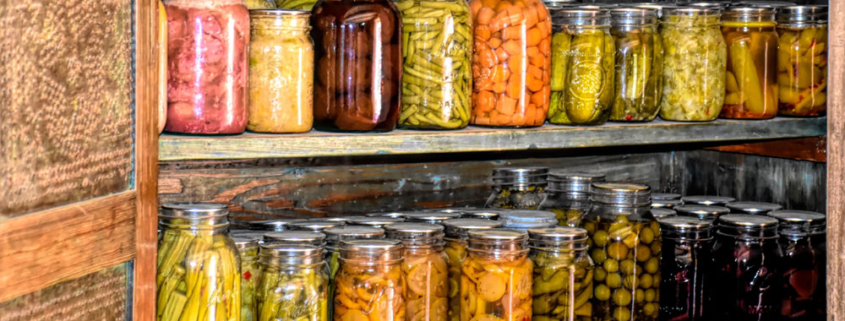How Do I Build a Root Cellar or Cold Room?
This article explores the essence of a root cellar or cold room, delving into its purpose, benefits, and the steps to build your own. Discover the timeless wisdom of harnessing nature’s refrigerator to keep your food storage, fruits, vegetables, and harvest bounty fresh throughout the seasons.
What is a Root Cellar?
A root cellar is a traditional storage space designed to provide cool, dark, and humid conditions for storing fruits, vegetables, and other perishables. It serves as a natural refrigeration system, extending the shelf life of produce and allowing individuals to enjoy homegrown or locally sourced foods long after harvest season has ended.
Why You’d Want One:
- Preserving Freshness: A root cellar creates an environment that mimics the cool, damp conditions found underground. This helps slow down the natural ripening and decay process.
- Energy Efficiency: Unlike modern refrigeration systems, root cellars operate without electricity.
- Preservation of Nutritional Value: The cool, dark conditions of a root cellar help preserve the nutritional value of stored fruits and vegetables. Minimal exposure to light and air slows down the degradation of vitamins and nutrients.
- Flavor Enhancement: Certain fruits and vegetables develop richer flavors when stored in a root cellar. The slow, natural aging process can enhance the taste and texture of items like apples, potatoes, and carrots.
- Versatility in Storage: Root cellars are versatile, accommodating a variety of produce, including root vegetables, apples, onions, and winter squashes. This diversity makes them an excellent solution for storing a wide range of homegrown or locally sourced foods.
How to Build a Root Cellar:
Consult a builder, or professional for specific instructions. Here in this article we will just mention the basics.
- Selecting a Location: Choose a site with good drainage, away from trees, and preferably facing north to avoid direct sunlight. The natural insulation provided by the earth ensures a stable temperature.
- Creating Ventilation: Install ventilation systems, such as vents or air pipes, to ensure proper air circulation. Adequate ventilation prevents the buildup of ethylene gas produced by stored fruits and vegetables, helping to prevent spoilage. Include measures to control humidity.
- Insulating Walls and Ceiling: Insulate the walls and ceiling to regulate temperature and humidity.
- Other Tips:
- Make sure the cellar is 10 ft deep
- Must be able to hold a temperature of 0° to 5°C and a humidity level of 85 to 95 percent
-
- The cooler temps slow the release of ethylene gas from the root vegetables and stop the growth of microorganisms, which slows down ripening and decomposition.
- The high humidity prevents loss of moisture through evaporation (no more withering)
-
- Communicate with your local authorities to ensure your property is safe to dig (ex: power lines, water table, sewer lines)
- Here is an interesting article from the Government of Canada giving some specific details
What is a Cold Room?
A cold room, often referred to as a pantry or cool storage room, is a designated space within a home designed to maintain a consistently cool temperature suitable for storing perishable items. Unlike traditional refrigerators, a cold room utilizes the principles of insulation, ventilation, and temperature regulation to create an optimal environment for preserving food.
Why You’d Want One:
- Extended Food Storage: A cold room allows for the extended storage of fruits, vegetables, canned goods, and other perishables, providing a solution for those who wish to stock up during harvest seasons or take advantage of bulk purchases.
- Energy Efficiency: Cold rooms typically consume less energy than traditional refrigerators, contributing to a more energy-efficient and eco-friendly household. This can lead to reduced electricity costs and a smaller environmental footprint.
- Wine Storage: Ideal for wine enthusiasts, a cold room provides a consistent and cool environment necessary for aging and preserving wines. It ensures that your wine collection matures gracefully and maintains its quality.
- Seed Storage for Gardeners: Gardeners can use a cold room to store seeds, preserving their viability for future planting seasons. The cool and dark conditions help prevent premature germination and maintain seed quality.
- Extended Flower Storage: A cold room is excellent for extending the lifespan of cut flowers. Flowers stored in a cool environment experience slower aging, allowing you to enjoy your floral arrangements for a more extended period.
- Cheese Aging: For those who enjoy homemade cheeses, a cold room provides an excellent space for aging and preserving cheese at the right temperature and humidity levels.
How to Create a Cold Room:
- Choose the Right Location: Select a location within your home that is easily accessible and can be adequately insulated. Consider spaces such as a basement, root cellar, or an interior room with minimal exposure to external heat sources.
- Insulate Walls and Ceiling: Insulate the walls and ceiling using materials like cold room panels, or rigid foam panels.
- Install a Ventilation System: Incorporate a ventilation system to ensure proper air circulation. This can include passive vents, fans, or air exchange systems to maintain freshness and prevent stale air or mold. Consider a thermostat to control the temperature within the cold room. Monitor humidity levels.
- Shelving and Organization: Install sturdy shelves for efficient organization of items. Consider adjustable shelving to accommodate various storage needs and maximize the use of space.
Conclusion:
Building a root cellar or cold room is a rewarding endeavor that connects us to traditional methods of food preservation while promoting sustainability and self-sufficiency. By embracing the simplicity of a root cellar, individuals can enjoy the flavors of a bountiful harvest year-round and contribute to a more resilient and mindful approach to food storage.



